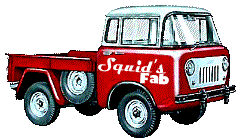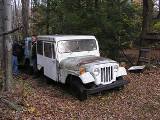 One of the "Jeeps' was a classic
'84 postal Jeep (I think the last year for these
things)
with an AMC Jeep 150 4. The other Jeep turned out to be a 1950 Willys
CJ3A. It was pretty rough from sitting outside for decades, but it was
a flatfender! Of course I was excited and they kindly offered them to me and I agreed to come back with a trailer.
One of the "Jeeps' was a classic
'84 postal Jeep (I think the last year for these
things)
with an AMC Jeep 150 4. The other Jeep turned out to be a 1950 Willys
CJ3A. It was pretty rough from sitting outside for decades, but it was
a flatfender! Of course I was excited and they kindly offered them to me and I agreed to come back with a trailer.
Jeep CJ3A Introduction
The Jeep Whisperer
This is about acquiring and
restoring a 1950 Willys CJ3A. Scroll down for the latest updates!
Willys Jeep Recovery and Rescue
In 2006, my internal Jeep Radar picked up the signal of a couple of Jeeps that were possibly going to be scrapped. Somehow I found out that a coworker's brother's son had them stored at his fathers house (didja get that?), but the son was moving far away, and the dad wanted the Jeeps gone. I was asked to take a look at them to see if I wanted them.
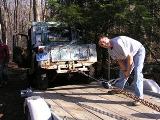 When I went back a couple of weeks later, the
euphoria
had worn off some and I could see
things a little more clearly this time.
When I went back a couple of weeks later, the
euphoria
had worn off some and I could see
things a little more clearly this time.
A good look at the Willys revealed that it was deteriorated to a pretty sorry state. The body was toast, the engine was seized solid, and it reeked of old rotten car stink from rodent damage in the old horsehair (or whatever the stuff is) seat stuffing. Yet I still felt compelled to take it home.
I had to make two trips and I took the postal Jeep first since it was in front of the CJ. Luckily my wife was cheerful when I arrived home with the postal Jeep. Shockingly, when I showed up next with the CJ3A, she said it was kind of cute!
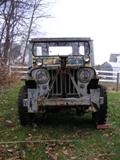 Still, the beads of sweat were pouring from me as I unloaded the Jeeps on a busy Saturday in my neighborhood with all the neighbors out and about.
Still, the beads of sweat were pouring from me as I unloaded the Jeeps on a busy Saturday in my neighborhood with all the neighbors out and about.
I got the postal running after about 24 minutes of cleaning rodent nests out of the air cleaner, and 1 minute of rapping the starter solenoid (ford style on the wheel well) with a wrench. It fired right up so I got in it and drove it around my yard. However, the first application of brakes immediately resulted in about 6 breaches in the brakelines. The body and frame had massive rust so I got rid of it.
Archeological CJ3A Findings
I knew very little about Willys Jeeps, so I did some research to learn about CJ3As, and then started to dig into my find. I love this sort of archeological stuff so prepare yourself:
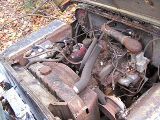 The
hood must have been open for a
long time because the head
was crusted with tree litter and the spark plug electrodes rusted right
out
of the head. This cannot be good.
The
hood must have been open for a
long time because the head
was crusted with tree litter and the spark plug electrodes rusted right
out
of the head. This cannot be good.
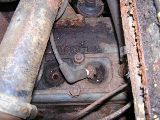 One
piece of paperwork I received with the Jeep indicates a '46 CJ2A engine
was
installed in 1961. The engine in there now however is a "Jeep
Industrial" Go Devil engine. This must be a 3rd engine.
One
piece of paperwork I received with the Jeep indicates a '46 CJ2A engine
was
installed in 1961. The engine in there now however is a "Jeep
Industrial" Go Devil engine. This must be a 3rd engine.
The Jeep has a Western Plow frame with a Monarch HiLo hydraulic pump. That stuff has been defunct for a long while probably, and there was no blade with the Jeep anyway. This Jeep seems to have spent most of it's life as a plow truck.
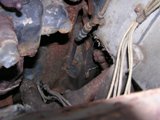 After
consulting some experts on www.CJ-3A.com,
I found out a bit about what this Jeep has. The engine bellhousing
"flange" shape helps date the engine block. This looks like a
late large flange. According to Bob Westerman's "Dating a CJ-3A" page,
this is a 1952 or later block. The block casting numbers on
the passenger side are: SD 908756.
After
consulting some experts on www.CJ-3A.com,
I found out a bit about what this Jeep has. The engine bellhousing
"flange" shape helps date the engine block. This looks like a
late large flange. According to Bob Westerman's "Dating a CJ-3A" page,
this is a 1952 or later block. The block casting numbers on
the passenger side are: SD 908756.
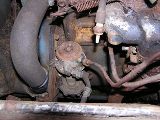
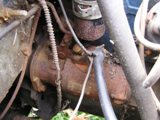 Check
out the details of the
starter and fuel pump. No tag on the starter. It
seems there is residue from a sticker there. A rebuilt unit?
The pinion yoke is frozen in place, but I think I can probably free it
up.
Check
out the details of the
starter and fuel pump. No tag on the starter. It
seems there is residue from a sticker there. A rebuilt unit?
The pinion yoke is frozen in place, but I think I can probably free it
up.
The body is shot. There is essentially no floor left. The tool box is pretty much all gone. The hood is bent and cracked but possibly salvagable. The fenders can probably be saved along with the grille.
The half hardtop is a Koenig Iron Works Supertop #355. It's the upscale version with bigger (and more) windows, and the doors have full roll up windows as well. It needs alot of sheet metal work but worth keeping.
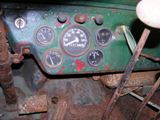 The
interior is pretty original with only a couple missing original
gauges. There is a Harrison heater under the dash too.
The
interior is pretty original with only a couple missing original
gauges. There is a Harrison heater under the dash too.
It looks like this Jeep was a workhorse it's whole life and consequently never modified much. Even the seats are original with remnants of gray vinyl-like upholstery. The stuffing is mostly gone however as the mice have found better uses for it.
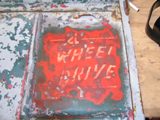 I
removed the tailgate and applied some elbow grease to it with some
sandpaper. I
carefully sanded until I uncovered the original "4 Wheel Drive"
stencil. This Jeep was originally Luzon red with the cream
colored stencils on the hood and tailgate. Over it's life it
was painted a brighter red, then green, then gray
primer. There is some yellow paint to be found here and there which was
probablya contrast color with the green.
I
removed the tailgate and applied some elbow grease to it with some
sandpaper. I
carefully sanded until I uncovered the original "4 Wheel Drive"
stencil. This Jeep was originally Luzon red with the cream
colored stencils on the hood and tailgate. Over it's life it
was painted a brighter red, then green, then gray
primer. There is some yellow paint to be found here and there which was
probablya contrast color with the green.
The Plan
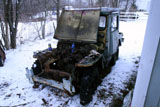 In
general, the fanbase for old utility CJ's is fairly small, so most
folks wouldn't have given this old thing a second look and sent it on
it's way to the boneyard.
In
general, the fanbase for old utility CJ's is fairly small, so most
folks wouldn't have given this old thing a second look and sent it on
it's way to the boneyard.
But if you "get" the Jeep thing, these old CJ's can make a perfect low budget project: They're small and don't take up much room, they're very simple (albeit with some old fashioned quirks), and can be pretty darn inexpensive to get running. My plan will be to get this ol' Jeep moving again, and maybe even looking good.
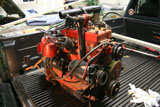 Since
the engine was junk, I found another engine for it after a few years of
patient
searching, and the first task will be to get that running.
Since
the engine was junk, I found another engine for it after a few years of
patient
searching, and the first task will be to get that running.
To see details about the engine work, go to the Flathead L134 Engine page.
To see details about the drivetrain rebuild, go to the CJ3A Drivetrain Rebuild page.
